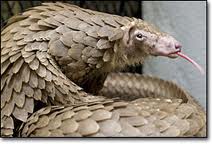We use cookies to make your experience better. To comply with the new e-Privacy directive, we need to ask for your consent to set the cookies. Learn more.
Endangered status

There are eight species of pangolin, of which four are Asian species (Indian ‘Manis Crassicaudata’; Malayan ‘Manis Javanica’ also referred to as ‘Sunda’; Chinese ‘Manis Pentadactyla’ and Palawan ‘Manis Culioensis’), and four African species (Cape or Temminck’s ground pangolin ‘Manis Temminckii’; Tree or African white-bellied pangolin ‘Phataginus Tricuspis’; Giant ground pangolin ‘Smutsia Gigantean’, and Long-tailed or black-bellied pangolin ‘Uromanis Tetradactyla’).
All eight species of pangolin are currently listed on the Convention on International Trade in Endangered Species (CITES) Appendix II, which means only limited trade is permitted. However, since 2000 a “zero quota” export ban has been in place for all Asian pangolin species, banning all international trade (CITES CoP 11), and many countries have also established legislation to further protect these animals from poaching.
In November 2010, pangolins were added to the Zoological Society of London's list of genetically distinct and endangered mammals.
Due to their solitary and nocturnal habits, tallies of pangolins are generally unreliable, and the International Union of Conservation of Nature acknowledges that there is “very little information available on the population status anywhere in the species' range." However, the organization concludes that pangolin populations are rapidly decreasing, and there have been suspected declines of 50% over the last 15 years, and projected continuing declines over the next 15 years, with the intensity of hunting steadily moving into the southern parts of the species' range.
In an interview for the Worldwatch Institute in November 2011, Chris Shepherd of ‘TRAFFIC’, the wildlife trade monitoring network, said "trade surveys and interviews with hunters and traders in many parts of Southeast Asia have indicated that populations of pangolins are in serious decline and in many locations are gone altogether.” (http://www.worldwatch.org/node/6198)
